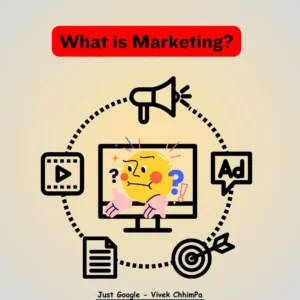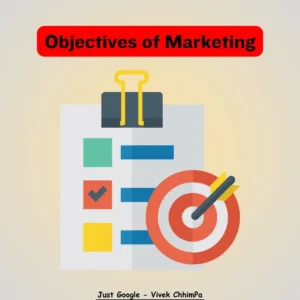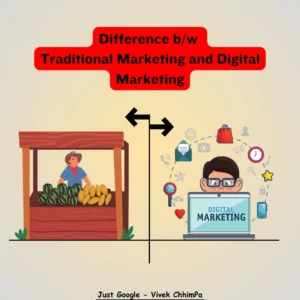To come into the existence of our brand or business, we need a system, called marketing. Without marketing, our businesses will be invisible to our neighbors. This chapter name – “Introduction to Marketing”, – is a chapter of the Digital Marketing Bootcamp.
In this chapter, we are going learn, what is marketing, the concept of marketing, the objectives of marketing, a few examples of marketing, the history of marketing, the 4Ps of marketing, what’s the difference b/w traditional marketing and digital marketing, marketing process, and the process of marketing conversion.
This is a part of Our Digital Marketing Bootcamp.
Let’s Start Now:
1.1 – What is Marketing?
Marketing is a plan of action that is used to drive sales, and traffic, increase our brand awareness, and drag a lot of sales to us.

To the Point; Reaching the right people with the right medium and strategy with desired concepts.
Marketing is embedded with finding the right customers, market research, and designing the product or services, according to the need or demand. So, effective marketing needs a strategy, plan, and smart execution.
This marketing strategy is further redesigned based on the demand or supply.
1.2 Concept of Marketing
Marketing is an ongoing process and needs proper tracking of conversion and execution of the strategy.

Here are a few basic concepts, we must be aware of these, are followings:
Sell or Showcase Your Product
We must be aware of; what is our product, its benefits, and its specialization or how this helps the person, who purchases it.
Then the next step is to give a price tag and make it ready to launch in the market.

Who is Our Audiences?
We must be aware of, to whom we are going to cater our product or services.

This concept is known as our target audience or potential audience.
This audience is further classified into hot and cold leads, and we must work on the strategy to reach more and more targeted audiences and generate sales or traffic.
Price of the Product
What is the cost of our products or services?
We must be aware of the average cost of our product or services, and the actual market value also. Is it still worth selling at a higher or lower value than our competitor?
Market Research of Your Product
Before selling our product, we must take care of market research.
Is our product already available in the market or a very relatable one to ours?
After, what are the benefits of that product or service, how is our product different from that, and how it is beneficial to the customers?
Customer Psychology
The psychology of customers plays a very important role in buying our products by their people.

We must be aware of what’s the interests of our customers or clients, so that we can modify our products or services, according to their interests and intentions.
As marketers, we must take care of this, to get the best out of the crowd.
How Helpful Our Product or Service is?
Is our product worth it?
What are the benefits of our product to the customers or clients?
Does this help them to make their life simple?
Here, we must be aware of the helpfulness of our product or services.
So, we must have all the above answers, before launching our product in the market.
These are the basic concepts of marketing, and as a marketer, we take care of these, and always beneficial for us.
1.3 Examples of Marketing
We must be aware of different marketing methods and here, we are going to know different examples of marketing.

Examples of Traditional Marketing
Traditional marketing includes print media, newspapers, brochures, pamphlets, magazines, billboards, radio shows, trade shows, etc.
Examples of Direct Marketing
Direct marketing includes SMS, coupon codes, freebies, discount offers, direct mail, telecaling, face-to-face marketing, etc.
Examples of Digital Marketing
Digital marketing includes search engine optimization, video marketing, email marketing, social media marketing, pay-per-click, etc.

Examples of Inbound Marketing
Inbound marketing includes blogging, content creation, search engine optimization, organic social media, email marketing, landing pages, direct CTA, etc.
Examples of Outbound Marketing
Outbound marketing includes TV ads, radio ads, cold calling, Cole email, sponsorships, outdoor events, self-promotion, etc.
Examples of Guerrilla Marketing
Guerrilla marketing includes street art, public flashes, sample distribution, stunt marketing, etc.
Examples of Organic Marketing
Organic marketing includes search engine optimization, content marketing, influencer marketing, social media marketing, local SEO, video marketing, community building, etc.

Examples of Inorganic Marketing
Inorganic marketing includes pay-per-click ads, display ads, outdoor marketing, sponsorships, affiliate marketing, direct email marketing, etc.
Examples of B2B Marketing
B2B marketing includes account-based marketing, trade shows, events, referral marketing, etc.
Examples of B2C Marketing
B2C marketing includes content marketing, email marketing, search engine optimization, social media marketing, etc.
So, these are a few examples of marketing with their different routes of marketing.
1.4 Objectives of Marketing
As a marketer, we must know the concept of marketing with objectives, so here, we are going to learn the main objectives of marketing are followings:

The main objectives of Marketing are as follows:
Research and Analysis
Market Research and Analysis; very core objectives of marketing.
Before launching any product or service, we must research our product, we work on factors like the demand or supply of that product.
So, Research and Analysis are very important aspects of our marketing strategy.
Target the Potential Audience
After the market research, the second objective of marketing is our targeted audience.
Here, we must be aware of whom we will sell our product or services.
What are the interests of our audience, their age group or gender, their geo-location, etc?
These factors are very important factors and matter a lot in your research and analysis process of marketing.
Networking
Networking is very important in marketing to build our brand authority, trustworthiness, and organic awareness and reach.

We can network with our local customers to international ones. We can start networking via different social media, local gatherings, events, online or offline seminars, webinars, etc.
Satisfy Consumers Need
Our product fulfills the needs of the buyer so that he or she can use our product or service again and again.
Along with this, we have to make our brand very simple, so that they can also recommend it to their family, friends, or relatives.
Generate Demand of Things
As a marketer, we must understand our product and how it will be useful for our build.
Along with this, we must create an urgency or need in the mind of our potential audience.

Generate Revenue
From the first objective of marketing – research and analysis to create a curiosity in the mind of our potential audience. These all steps are followed to generate revenue.
Here, we have to focus on the actual cost of our product or services and cross-check the total revenue generated. So that we can calculate the final profit or loss easily.

Promote Two Way Communication
Marketing is a two-way of communication because here we can work on customer reviews, and make their experience more personalized.
This works in a feedback mechanism loop and is also considered one of the objectives of marketing.
1.5 History of Marketing
The history of marketing is a concept from human civilization. When people start developing societies, and communities, and here their demand is increased for any product or item.
These needs lead to working more and producing more products like food, clothes, etc.

These can be produced by a single one or can be purchased from other resources. They started exchanging their products with each other, to fulfill their needs and roles, and this concern was known as the Barter system.
Here; the concept of marketing evolved.
The history of marketing is covered from the industrial revolution to the sales era, and now modern digital marketing.
In the sales Era, there was no concern about system satisfaction, they were primarily focused on sales until as soon as possible.
At that time, companies used mediums like television, radio, door-to-door sales, etc.
in 1990; the marketing scenario changed when modern marketing techniques were introduced.
Modem marketing techniques take care of buyers’ needs and demands and then modify or present them as per customer needs.
Rise of Digital Marketing
After the penetration of the internet, most marketing channels were shifted to online. Here, more than 50% population gets connected via the internet.

First personal computers were introduced, followed by smartphones, social media, new information, and now personalization which is the full swing.
Here brands like Coca-Cola, Disney Entertainment, Maggie, Mountain Dew, etc dominated the market via direct digital marketing channels.
The marketing techniques rise based on increased competition, business demand, internet marketing, etc.
Many modern techniques include search engine optimization, blogging, and social media marketing.
1.6 4P’s of Marketing
The 4P of marketing is a key consideration of the marketing mix and is a very crucial concept of Chapter 1 – Introduction to Marketing.
Here; the 4Ps in marketing expand as Product, Price, Place, and Promotion.

These 4P’s take care of our venture, what its demand is, and pricing with sharing and distribution. These calculate the benefits and risks of your product or services to a higher extent level.
Product
Product in marketing is the item or plan that we are going to offer to our clients and customers.
We must be aware of our product, and its benefits because we are going to sell the benefits, not that item.

How that item will be helping our clients or customers to make their life easy.
We must do homework like who is our competitor, whether our product needs extra definition or can be sold easily in the market, or if any other products same or related to my product items.
As a marketer, it’s our responsibility to introduce our product to the right audience or customers.
So, in Brief, the Product covers the following:
- What’s our product?
- Benefits of our product,
- Who is our potential audience?
- How our product is different from others?
This questionnaire helps us to identify and research most of the market easily for our product or services.
Price
Price in marketing is at what amount we are going to sell our products or services.
We must be aware of the total cost of our product, taxes, distribution charges, and all to calculate the return on the investment.

We must check the final amount of the product and compare it with the market value, whether it is suitable or not, or maybe high or low, based on the market demand.
Whether we can afford these with coupon codes or in discounted pricing, etc has also evolved.
Pricing in marketing covers the following-
- The overall cost of our product,
- The current selling price of our product,
- What is the pricing of our competitor’s product?
- Is this price value suitable for our targeted audience?
Place
Place in marketing is defined as how we are going to distribute our product.

Do we need any physical location or online space, or we can go to work on these both?
Place in marketing includes these;
- Which is the best medium to sell our product?
- Where does our potential audience exist?
- Which is the best channel to reach our potential audience easily?
Promotion
The last but not least P of marketing is Promotion.
Promotion is the activities through which we are going to create awareness of our products or how to tell people about our product.

Promotion includes direct selling, pamphlets, distribution of product pages in the newspaper, road hoarding, events, open shows, sponsorships, etc.
Promotion includes these:
- Which time slot is best suited to reach our targeted audience?
- Which platform best suits you?
- Can I go for paid or organic mediums?
- Is this strategy enough or need to change?
1.7 Difference b/w Traditional Marketing and Digital Marketing
These marketing methods are used at individual or industrial levels. These both have their benefits and risks, based on the venture, we choose these.

There are a lot of differences between traditional l marketing and digital marketing. Let’s discuss that now:
What is Traditional Marketing?
Traditional marketing is the marketing technique, that has been used from ancient times to today.
We use this method to promote or sell our services and products.
Traditional marketing includes television ads, roadside banners, radio ads, flyers, newspaper managers, door-to-door pamphlet distribution, etc.
Traditional Marketing Methods
A few methods of traditional marketing are outdoor marketing, direct marketing, and event marketing, including roadside banners, door-to-door selling, loudspeaker ads, etc.

What is Digital Marketing?
Digital marketing is the modern method of marketing, where almost all digital platforms or mediums are used to sell our products or services and help in brand value creation.
Digital marketing includes promotion, branding, and selling, via online mediums such as social media like Instagram, Facebook, YouTube, google, Snapchat, etc, then followed by organic and inorganic mediums.
Digital marketing is covered by the creation of the plan, then executed and followed by conversation, and then revision and updates are entertained, based on the level.
Digital Marketing starts with creating interest in our product, followed by brand awareness to creating a desire and finally encouraging them to make decisions and buy that product or service.
Digital Marketing Methods
A few digital marketing methods are search engine optimization, google ads, Facebook ads, Social media marketing, and affiliate marketing.

Difference Between Traditional and Digital Marketing
There is a lotus of differences between traditional and digital marketing; which are as follows;
Here are a few key differences between traditional and digital marketing are followings:
- Traditional marketing uses old methods like newspaper ads, roadside banners, and events, and is mostly covered by outdoor mediums, on the other hand, digital marketing is performed completely remotely, with mediums like SEO, SEM, SMO, Google ads, FB ads, email marketing, etc.
- Traditional marketing is more costly than digital marketing, and sometimes unable to track the conversion, So, digital marketing is very cost-effective.
- Traditional marketing is easy to learn but digital marketing takes time to become an expert in any domain, and a basic to advanced understanding is required in digital marketing, based on the level of marketing.
- Digital marketing is analyzed by many tools like Google Analytics, track of spend vs conversion, etc, but in traditional marketing, there are very few measuring concepts.
Hence, digital marketing is the best choice for today’s marketing method. Because it is highly measurable, low-cost, with better analysis and targeting.
1.8 Marketing Process
The marketing process is a strategy for our product or services, to satisfy the customer’s need or demand.

This includes our target audience, competitors analysis, return on investment, and much more.
Marketing Process Includes:
The marketing process includes all these concepts;
- Customer’s needs, wants, or demands.
- Interest of targeted audience,
- Budgeting,
- Pricing,
- Medium of promotion,
- Return on investment.
These are the key components of the marketing process, to execute that perfectly and; also help in final revenue generation, or lead conversion with proper tracking or analysis.
1.9 Marketing Conversion
The marketing conversation is the concept of converting your visitors into our customers.
To execute this, we use many methods like e-books, free guides, free lectures, courses, etc.

Marketing conversion is calculated based on the investment upon your return, where we calculate the profit or loss.
Marketing conversion methods may be organic or inorganic, based on our marketing process or strategy.
Last Words
In this chapter named – “Introduction of Marketing” of digital marketing boot camp, we learn all about here is what is marketing, the concept of marketing, the objectives of marketing, a few examples of marketing, with the history of marketing, including 4P;s of marketing, and difference b/w traditional marketing and digital marketing, along with the marketing process, and marketing conversion.
Disclaimer
This chapter is designed by “Vivek ChhimPa”, based on his knowledge, learnings, and experience.
This is for educational purposes only, to provide the best education in digital marketing.
If you want to use this content, then, you must give proper citation or proper attribution to the author here.



